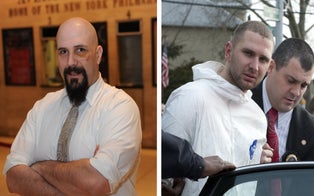Gacy was arrested in 1978 after killing 33 people.
The forthcoming Peacock docuseries, “John Wayne Gacy: Devil in Disguise,” examines the life of notorious serial killer John Wayne Gacy and tries to shed light on the investigation into what led to his arrest.
John Wayne Gacy — "the worst animal to ever have existed in this century.” That's how former Cook County State's Attorney Terry Sullivan described one of the most infamous serial killers in a 1991 interview with Inside Edition.
Between 1972 and 1978, Gacy tortured and murdered at least 33 teenagers and young men inside his own home. At the time of his arrest, he was known as the largest mass murder in the history of the United States.
Gacy seemed to be a pillar of his community, meeting politicians like first lady Roslyn Carter and appearing at charity events as a clown to entertain children. But the clown costume would become his murderous calling card, and the media would eventually dub him “The Killer Clown."
On the 25th anniversary of his execution, take a look back at John Wayne Gacy's gruesome reign of terror.
A Troubled Past
He grew up in a blue collar family in Chicago and reportedly experienced an abusive childhood. His father was reportedly a drunk who beat Gacy and his siblings, as well as their mother.
As an adult, Gacy became a portly man with slick hair that resembled Elvis Presley in his early career. At the age of 22, he was married in 1964 to Marlynn Myers. They had two children: Michael, born in 1966, and Christine, born in 1967.
Gacy was well-liked in the community, but he was not without troubles. In 1968, he was convicted of sexually assaulting two teen boys and was sent to prison for it. Gacy and Myers divorced before he was released on parole in 1970. By 1971, he was charged again with sexual assault, but the case was later dropped.
Gacy was married again soon after these first run-ins with the law. In mid-1972, he married Carole Hoff. Little did she know, he had already killed his first victim.
A Clown Emerges
Gacy took his first life in January 1972, stabbing a teenage boy to death in his home. He did not continue this method of killing, however. His m.o. changed with his next victim.
It was in the early 1970s that Gacy began dressing up as a clown, which he called his alter ego, “Pogo the Clown.” He appeared at children’s parties and charity events. He also went on to own his own construction company in a Chicago suburb.
"Pogo" would play a role in his later killings. Gacy would lure his victims to his home by pretending to be a police officer or falsely promising them work in construction. Then, often times dressed as "Pogo," he would drug and sexually assault his victims. He then strangled almost all of them and buried as many bodies as he could in the crawl space of his home.
He would only dump four bodies in the Des Plaines River because his crawl space was full.
Despite the foul stench of decaying bodies in his home, Gacy was even able to convince his wife and guests that the smell coming from the crawl space was simply mold and moisture building up.
The Brutal Rampage Ends
By 1978, Gacy had been divorced from Hoff and he had fixed himself as leader in the community, hosting parties and continuing to dress up as "Pogo." But his dark side finally met the light after 15-year-old Robert Piest was reported missing.
Cops learned that Gacy was the last to see the teen, and they obtained a search warrant to look in the construction owner’s home.
“We found other pieces of identification that belonged to other young male individuals and it didn’t take too long to see that there was a pattern here that the identifications belonged to people who were missing throughout the Chicago-metro area,” Des Plains, Illinois, Chief of Police Joe Kozenczak told Inside Edition in 1991 about searching Gacy’s home.
Cops eventually uncovered 29 bodies in the crawl space.
The Confession
Kozenczak said Gacy soon confessed to him in gruesome detail about how he killed his victims.
“John used to like to read The Bible and certain excerpts from The Bible to his victims as they were dying,” Kozenczak said. “He was essentially not finished with the victims once they died because he was a necrophiliac.”
One man, who managed to escape Gacy’s clutches, spoke to Inside Edition in 1991. The man, only identified as Jim, said Gacy pretended to be a cop when they met at a bar. Gacy and Jim struck up a conversation, and Jim was then invited to the killer’s house to do drugs.
Jim said he was given street drugs and a batch of narcotics that he had never heard of before. The drugs knocked him out, and when he woke up, he said he saw Gacy sexually assaulting him.
“I tried to push him off and I couldn’t,” Jim said. “I told him I wanted to go back to my car, so he said, ‘OK, I gotta go to church anyway, so I will give you a ride back.’ He gave me a ride back and he gave me a handful of speeders and I got in my car and I went home.”
Jim said he left “as if nothing happened,” later admitting, “I got lucky he didn’t kill me.”
A Killer Is Put Away
In 1981, a jury in Cook County, Illinois, found Gacy guilty on 33 counts of murder. He was sentenced to death.
Gacy would spend 13 years on death row while in prison. But his name didn't disappear from public view. He found acclaim and notoriety as an artist, selling painting from behind bars. Some of his paintings included self portraits, landscapes and images of children’s characters like the Seven Dwarfs from “Snow White,” as well as “Pogo."
His paintings would even circle around in galleries around the country, in cities like Chicago and Boston.
Gacy would also get tons of fan mail, which he would respond to with his own personal stationary. Many of his letters and paintings were compiled in a book called “They Call Him Mr. Gacy,” which was released in 1989. It is unknown if the killer profited from the sales of the book, but it was reported that the anthology sold a “substantial amount” of copies.
This infuriated the relatives of his victims.
“Certainly his abilities to get his name out and his paintings out and all of the rest of the things outside the jail walls is something that just adds another burden to the back of the victims families who are out there right now,” Sullivan, the former Cook County state attorney, told Inside Edition in 1991.
However, Gacy wouldn't have much longer to profit from his art. He was executed by lethal injection on May 10, 1994.
Dolores Nieder, the mother of victim John Mowery, spoke to Inside Edition in 1991, outraged by the damage Gacy continued to inflict from behind bars.
“When you lose a child it is like taking a little piece of your heart out. Now, Gacy has stolen something from me that I just can’t forgive him. I can’t forgive that man,” she said.
RELATED STORIES





